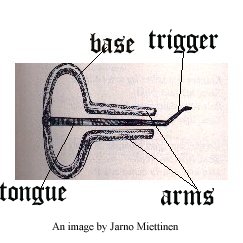The english name of this instrument has nothing to do with jews. The original form of the name was once jawharp because it is played between jaws, of course. During hundreds of years name was turned into jew's harp.During the medieval times jew's harp was connected to witchcraft in Europe and it created bad reputation to a jew's harp. It may be another reason for the name. Jew's harp was small instrument with rude sound while the christian (orchestral) harp was massive, expensive and had beautiful sound. This was the opinion of catholic chruch dominated Europe.
Main parts of a jew's harp are: tongue which creates its significiant sound and frame to which tongue is attached. (Look the picture on the bottom of this page.)
A jew's harp is played by pressing the harp against the front teeth which must be slightly apart because the tongue needs space to vibrate. Then the tongue is striked by forefinger. Now vibration will amplify in the mounth. Changing the size of the mounth, position of player's tongue and slightly pronouncing the wovels will add overtones and colours to the sound. In this way parts of the natural scale can be played. In- or exhaling through the harp will create more powerful sound.
Today jew's harp is known throughout the world. Here are the names of jew's harp in selected languages:

finnish - munniharppu or märistysrauta (which means trembling iron)
swedish - en mungiga (which means mouth fiddle),
norwegian - munnharpa or munnharpe
german - die Maultrommel (which means mouth drum)
france - une guimbarde
japanese - koukin
russian - vargan
italian - scacciapensieri
latin - trombula
bali - genggong
yakut - khomus
kazakh, kyrgyzh and uzbek - kobyz
bashkir - kubyz
